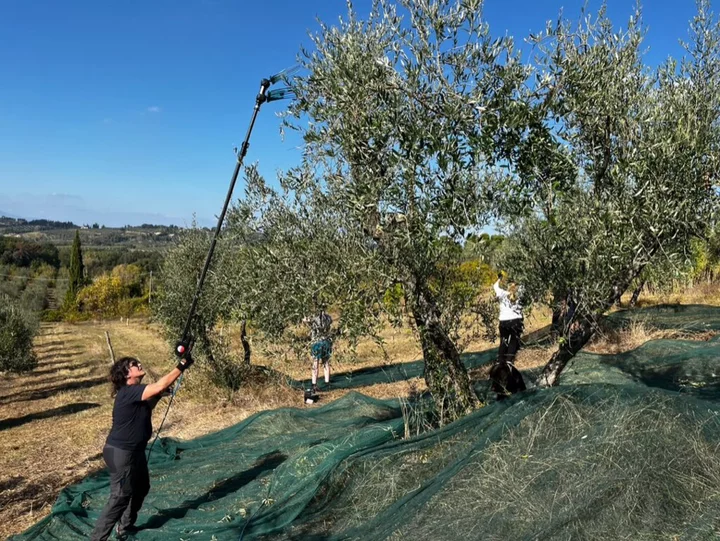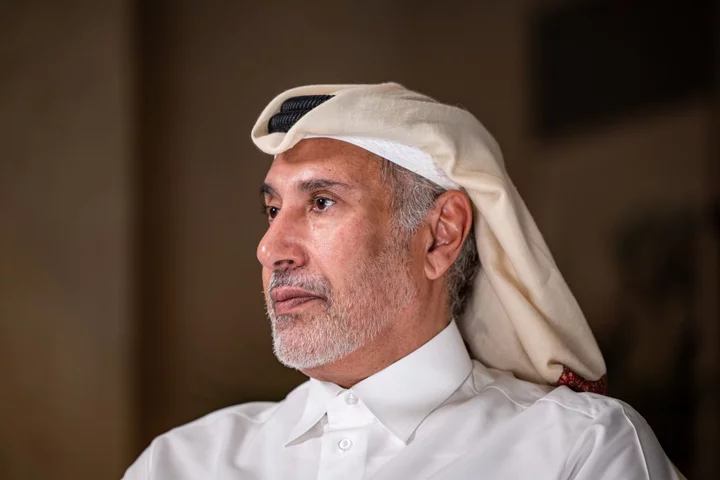Maria Angela Macchia jams a 10-foot pole topped with an electric comb into the upper reaches of a 200-year-old olive tree and revs the engine. The long-toothed tool, created to extract stubborn fruit from the highest branches, vigorously shakes the crown of the tree, sending a trickle of olives cascading to the green nets below. To an onlooker, the stream is impressive. But Macchia frowns: The yield is only a fraction of what she got when she shook the same tree the previous year at I Moricci, her 19th century farmhouse on Tuscan hillside outside of Peccioli, southeast of Pisa.
Extreme rains across Italy in the spring knocked many of the olive flowers off Macchia’s 900 trees before the fruit could form, and she’s expecting this year’s oil output to plummet by about three-quarters. To help make up some of the earnings shortfall, Macchia has been hosting groups of tourists, organized through the Rotterdam-based vacation planners Triptoscana. The visitors stay on her farm and help pick the olives and explore the region during down time. At the end, they get a half-liter bottle of oil to take home.
The nine-member group I joined representing four nationalities reflects a growing movement in olive oil tourism across the Mediterranean. Travelers get a taste of the work that goes into producing some of the world’s top extra virgin olive oil, while they provide an alternate source of revenue for farmers whose earnings have increasingly suffered from rising production costs and the effects of extreme weather linked to climate change.
“People really take part in the harvest—they get into the rhythm of it,” Macchia says. But, she adds, “it’s a lot of work. Every year is different to the next, and there’s a lot that goes into making the oil that gets to their tables.”
Triptoscana’s five-day tour costs €745 ($810), including two days of picking and a visit to the frantoio—the place where the bitter-tasting fruit is pressed into the liquid gold that is extra virgin oil. Macchia benefits from booking apartments at I Moricci that might normally be empty during off-season; she also has free labor helping her harvest the olives. Our group spent about six hours in the field each day; the roughly 500 kilograms (1,100 pounds) we picked over the two days would yield about 70 liters of oil.
Macchia’s olive shaker—two oversize comb-shaped heads on a telescopic pole powered by a car battery—is as high-tech as picking gets at an independent farm like hers. After the tree tops are combed, guests use plastic hand-rakes to scrape the remaining olives off, branch by branch.
After picking, the olives are taken directly to the press to stop natural oxidation from spoiling the fresh flavor. Outside the frantoio, where the heady smell of olive oil hangs like a cloud, local farmers wait outside as if they were expectant fathers: Their harvest passes through an assembly line of machines that clean the olives before mashing them into a pulp and then separating the oil from the remaining sludge. Every byproduct is used. The pulp serves as fertilizer or is sold to commercial producers to extract more nectar for lower-grade oils. The bits of crushed olive pits are dried and sold as fuel for wood-burning stoves.
To be considered extra virgin oil, the olives must be cold-pressed mechanically and have an acidity of less than 0.8%. The oil, which can cost upwards of €30 a liter, has rich, earthy flavors and often a spicy aftertaste. It’s primarily a condiment used to drizzle on top of soups, fish and vegetables, to mix into salads and sometimes for sautéing.
In fact, cooking with olive oil is costlier than ever. The hit to harvests linked to extreme weather has coincided with a surge in demand from health-conscious consumers. Global olive oil production is expected to fall this season to 1.97 million tons, a 23% decline from the average of the previous four years, according to Olive Oil Times, a trade publication that tracks the industry. Spain, which has traditionally produced about half the world’s olive oil, is suffering a second year of drought that cut last year’s harvest by more than half; only marginal improvement is expected this year. Greek producers were slammed by cataclysmic rains and hail in September that damaged trees. Greek oil production is expected to drop 40% from last year’s bumper crop, Olive Oil Times reported. Meanwhile, in Italy, the cost of olive oil was 49% higher in October than in the previous year; in Spain, where grocers are now locking up olive oil to combat shoplifting, it’s up almost 74%.
My Spanish-born colleague Javier Blas, who covers the petroleum industry for Bloomberg, recently wrote about his personal shock at seeing the price of olive oil rise to an all-time record this year, contributing to the jump in the cost of all kinds of classic Mediterranean dishes from paella to pizza. In August, a metric ton of olive oil cost about 10 times a metric ton of crude. In 2019, he wrote, the cost ratio was less than 5 to 1.
Producers such as Macchia may be able to charge top dollar for premium oils, but it’s not enough to compensate for the drop in output and the rising cost of fertilizer, labor, glass bottles and electricity. That’s where the olive tourism movement hopes to make a difference. Olive-picking experiences and oil tastings have been available for some years in Mediterranean countries, but Italy is using a new law that came into effect last year to try to attract tourists to olive groves outside of picking season.
Budget law 169/19 makes it easier for producers to charge admission for events related to oil production and is modeled on similar legislation for wine that helped Italian wine producers become international favorites. Events range from concerts in century-old olive fields to meditation and yoga sessions among the trees to cycling and trekking routes in growing regions. More than 25,000 people took part in a “Walk Through the Olive Fields” event in 163 oil-producing towns and villages in October, organized by Citta dell’Olio, a national alliance that backs the tourism effort.
Fabiola Pulieri, an olive oil sommelier, who literally wrote the book on the subject—Olive Tourism, Opportunities for Producers and Regions (Agra Editrice)—says olive tourism could help raise the profile of independent producers much like Italy’s wine law created brand awareness about Italian wines.
“Now there are opportunities 365 days a year, not just during the harvest and pressing season in October and November to take advantage of tourism and give an economic boost to producers,” she says.
Other countries offer similar opportunities, for olive-oil-minded tourists. Good Life Greece organizes picking holidays on the island of Syros, and the olive groves are a five minute walk from the beach. You can pick Dalmatian olives off 1,000-year-old trees in Solta, Croatia, organized by Olynthia, a premium brand oil. Fans of Don Quixote can visit the groves of Garcia de la Cruz in La Mancha, Spain, with same-day olive-picking tours that includes a visit to their 17th century olive press (and yes there are windmill “to tilt at”).Struggling producers see a side benefit to increased tourism—namely, the recognition of the amount of work that goes into making one little bottle of olive oil. “The most important thing is that [people] get to see that you don’t just open the faucet and oil comes out,” Macchia says.
“After you have gone through that, you think to yourself, ‘Good oil should be expensive for all the trouble it takes to produce,’” says David Sheridan, a senior judge at the Hartford Superior Court, who made the trip to I Moricci with his wife and daughter.
Macchia, who gave up her career as a goldsmith 25 years ago to go into farming, says she’s hopeful the tourism push will get more people interested in top-quality oil like hers.
“Out of 100 people, there are probably four that are interested in olive oil,” she says. “But for me, that’s enough, and those are the people I want to focus on.”









